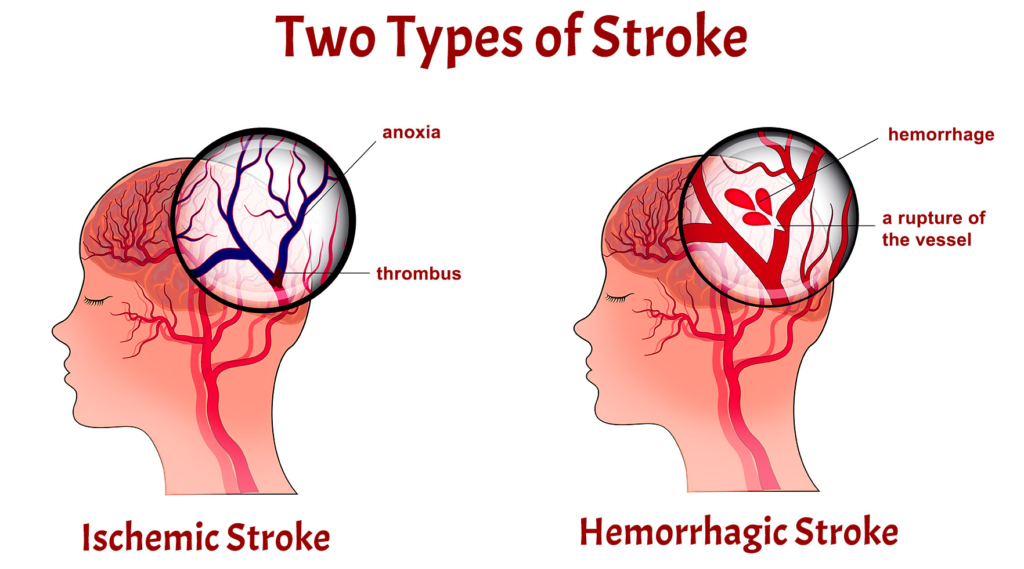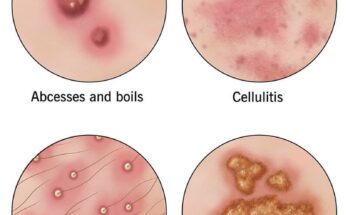Stroke is a major medical emergency and a leading cause of death and long-term disability worldwide. It occurs when blood flow to the brain is interrupted, resulting in damage to brain cells due to a lack of oxygen and nutrients. Understanding the causes, prevention strategies, and treatments for stroke can be life-saving and crucial for reducing both the incidence and impact of this condition.
What is a Stroke?

A stroke occurs when the blood supply to part of the brain is cut off. Brain cells, which depend on a steady supply of oxygen and nutrients, start to die when blood flow is reduced or stopped for even a few minutes. The effects of a stroke vary depending on the area and extent of the brain affected, but they often include loss of movement, speech impairment, memory issues, and other neurological changes.
Types of Stroke

Strokes are classified into two main types, with distinct causes and treatments:
- Ischemic Stroke: This type accounts for about 87% of strokes. It occurs when blood clots or fatty deposits block an artery in the brain. There are two subtypes of ischemic stroke:
- Thrombotic Stroke: When a clot forms within one of the arteries supplying blood to the brain.
- Embolic Stroke: When a clot forms in another part of the body, often the heart, and travels to the brain.
- Hemorrhagic Stroke: This type occurs when a blood vessel in the brain bursts, causing bleeding within or around the brain. Hemorrhagic strokes can result from high blood pressure, brain aneurysms, or arteriovenous malformations (AVMs).
A third, less severe type of stroke, known as a Transient Ischemic Attack (TIA) or “mini-stroke,” occurs when blood flow to the brain is temporarily disrupted. TIAs don’t cause permanent brain damage, but they are a critical warning sign of a potential major stroke in the future.
Causes of Stroke
Strokes result from a complex interaction of genetic, lifestyle, and health factors. Here are some of the most common causes:
- High Blood Pressure (Hypertension): Chronic high blood pressure is one of the leading causes of both ischemic and hemorrhagic strokes.
- Heart Disease: Conditions like atrial fibrillation, irregular heartbeats, and heart valve problems can increase the risk of blood clots that can travel to the brain.
- Diabetes: High blood sugar levels can lead to damage in blood vessels, making individuals more susceptible to clots and bleeding.
- High Cholesterol: Elevated cholesterol levels lead to plaque buildup in the arteries, increasing the risk of an ischemic stroke.
- Smoking: Smoking damages blood vessels and increases clot formation, which raises stroke risk significantly.
- Obesity and Inactivity: Obesity, especially when accompanied by a sedentary lifestyle, is a major contributor to other stroke risk factors such as hypertension, diabetes, and high cholesterol.
- Age and Genetics: The risk of stroke increases with age and is also higher if there’s a family history of stroke.
Stroke Symptoms: Recognizing the Signs
Knowing the symptoms of stroke can be crucial for seeking timely medical help. The acronym FAST is widely used to remember the key signs of stroke:
- Face drooping: One side of the face may appear uneven or droopy.
- Arm weakness: Inability to raise one or both arms.
- Speech difficulty: Slurred or garbled speech.
- Time to call emergency services: Immediate help is essential.
Other symptoms may include sudden confusion, trouble seeing in one or both eyes, severe headache with no known cause, dizziness, or difficulty walking.
Stroke Prevention: Strategies to Lower Your Risk
Preventing stroke is often about managing lifestyle factors and controlling underlying health conditions. Here are some evidence-based strategies:
- Control Blood Pressure: Keeping blood pressure within a healthy range (below 120/80 mm Hg) is critical. This may require a combination of lifestyle changes and medication.
- Manage Diabetes: If you have diabetes, maintain blood sugar levels through medication, diet, and exercise.
- Quit Smoking: Smoking cessation significantly lowers the risk of stroke by improving overall vascular health.
- Exercise Regularly: Aim for at least 150 minutes of moderate aerobic activity each week. Exercise helps reduce blood pressure, maintain healthy cholesterol levels, and manage weight.
- Eat a Balanced Diet: Focus on a diet rich in fruits, vegetables, lean proteins, and whole grains. Limit saturated fats, trans fats, and added sugars, which can contribute to high cholesterol and obesity.
- Limit Alcohol: Heavy drinking can raise blood pressure and increase stroke risk. Moderation is key—up to one drink per day for women and two for men is generally considered safe.
- Control Cholesterol Levels: Maintaining a healthy cholesterol level helps prevent plaque buildup in arteries. A low-fat diet, regular exercise, and possibly medication can help achieve this.
- Monitor Heart Health: Conditions like atrial fibrillation or other heart issues can increase stroke risk. Regular check-ups and medication, if necessary, can manage these conditions effectively.
Stroke Management Using STEM Therapy
Stem cell therapy is a cutting-edge field of medicine that is showing promise for preventing and managing strokes. This innovative treatment focuses on harnessing the body’s ability to repair damaged tissue using stem cells, which are unique cells with the potential to develop into various specialized cell types. In stroke patients, stem cell therapy aims to replace or repair damaged brain cells and improve neurological function, offering new hope for recovery.
How Stem Cell Therapy Works in Stroke Treatment
In the context of stroke, stem cell therapy primarily targets the brain cells damaged due to interrupted blood flow. When a stroke occurs, parts of the brain are deprived of oxygen and nutrients, causing cells to die and leaving behind damaged tissue. This damage can result in long-term issues with movement, speech, and other cognitive functions.
Stem cell therapy involves introducing healthy stem cells into the brain. These cells can help repair damaged areas by:
- Regenerating Neurons: Stem cells can develop into neurons (brain cells) and replace those lost during a stroke.
- Releasing Growth Factors: Stem cells release various growth factors that promote healing and encourage surrounding cells to repair themselves.
- Reducing Inflammation: After a stroke, inflammation can worsen brain damage. Stem cells have anti-inflammatory properties that can reduce this effect, helping to limit further injury.
STEM CELL Product for Managing Stroke
Some health supplements have proven successful in helping manage stroke using STEM Cells below is one of them.

Stroke Treatment: Medical and Surgical Options
The treatment of stroke depends largely on the type of stroke and how quickly medical intervention is sought. The primary goal is to restore blood flow to the brain as quickly as possible to minimize damage.
Ischemic Stroke Treatments
- Thrombolytic Therapy: Known as “clot-busting” treatment, thrombolytics like tissue plasminogen activator (tPA) can dissolve clots if administered within 3 to 4.5 hours after the onset of symptoms.
- Endovascular Procedures: In cases where thrombolytic drugs are not suitable, doctors may perform a mechanical thrombectomy. This minimally invasive procedure involves removing the clot directly from the blocked artery.
Haemorrhagic Stroke Treatments
- Surgical Intervention: In cases of hemorrhage, surgery may be necessary to repair the damaged blood vessels or remove pooled blood.
- Blood Pressure Management: High blood pressure control is critical to prevent further bleeding in the brain.
- Coil Embolization or Clipping: If an aneurysm causes the bleeding, doctors may use techniques such as coil embolization (blocking the aneurysm with coils) or clipping to prevent further hemorrhage.
Stroke Rehabilitation
Rehabilitation is crucial for recovery and may include:
- Physical Therapy: Helps regain motor skills and strength, particularly if there is paralysis or muscle weakness.
- Speech and Language Therapy: Assists with language, speech, and swallowing difficulties often resulting from stroke.
- Occupational Therapy: Aims to restore skills needed for daily activities, such as dressing and grooming.
- Psychological Support: Stroke can lead to anxiety, depression, and emotional instability. Counseling and support groups can be beneficial.
Emerging Treatments for Stroke
Research into stroke treatment is ongoing, and several promising treatments are in development:
- Stem Cell Therapy: Preliminary studies indicate that stem cell therapy may help repair damaged brain tissue, although more research is needed before it becomes widely available.
- Neuroprotective Drugs: Researchers are working on drugs that can protect brain cells and reduce the extent of damage during a stroke.
- Advanced Rehabilitation Technology: Robotics, virtual reality, and brain-computer interfaces are being explored to enhance recovery and rehabilitate lost functions.
Conclusion
Stroke is a complex medical condition with life-altering consequences. By understanding its causes and risk factors, taking preventive steps, and recognizing the signs early, individuals can significantly reduce their risk and improve outcomes if stroke does occur. Advances in medical treatments and rehabilitation methods continue to offer hope for better recovery and quality of life for stroke survivors. Immediate medical intervention, lifestyle changes, and ongoing research hold the key to a future where the burden of stroke can be greatly reduced.



